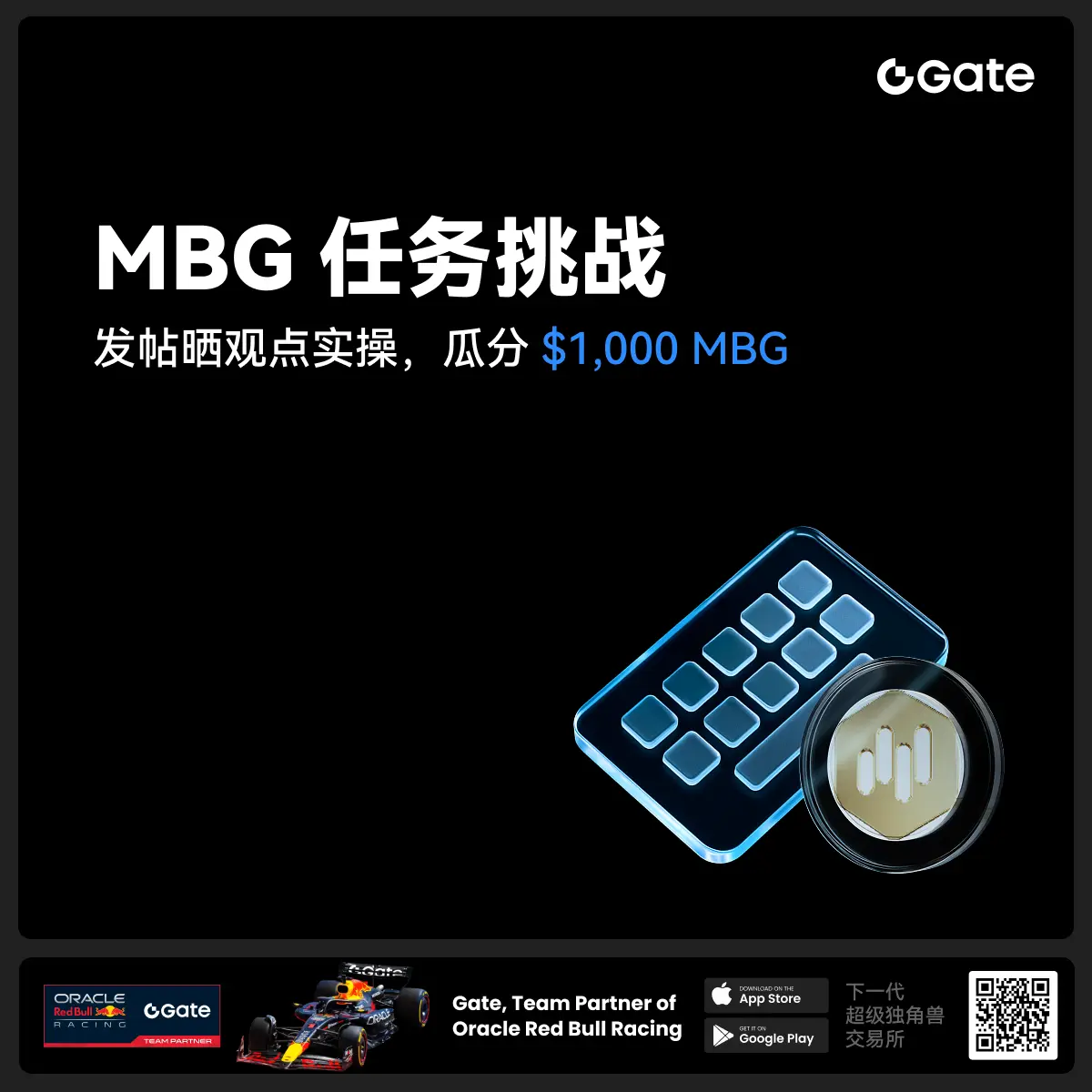- 话题1/3
5k 热度
15k 热度
8k 热度
49k 热度
20k 热度
- 置顶
- 📢 Gate广场 #MBG任务挑战# 发帖赢大奖活动火热开启!
想要瓜分1,000枚MBG?现在就来参与,展示你的洞察与实操,成为MBG推广达人!
💰️ 本期将评选出20位优质发帖用户,每人可轻松获得50枚MBG!
如何参与:
1️⃣ 调研MBG项目
对MBG的基本面、社区治理、发展目标、代币经济模型等方面进行研究,分享你对项目的深度研究。
2️⃣ 参与并分享真实体验
参与MBG相关活动(包括CandyDrop、Launchpool或现货交易),并晒出你的参与截图、收益图或实用教程。可以是收益展示、简明易懂的新手攻略、小窍门,也可以是现货行情点位分析,内容详实优先。
3️⃣ 鼓励带新互动
如果你的帖子吸引到他人参与活动,或者有好友评论“已参与/已交易”,将大幅提升你的获奖概率!
MBG热门活动(帖文需附下列活动链接):
Gate第287期Launchpool:MBG — 质押ETH、MBG即可免费瓜分112,500 MBG,每小时领取奖励!参与攻略见公告:https://www.gate.com/announcements/article/46230
Gate CandyDrop第55期:CandyDrop x MBG — 通过首次交易、交易MBG、邀请好友注册交易即可分187,500 MBG!参与攻略见公告:https://www.gate.com/announcements
- 🎉 Gate广场“星火计划”入驻KOL突破1000人!
💥 创作者生态迎来全面爆发期!
📈 上首页、拿奖励、赢影响力,你还在等什么?
💰 现金激励 ✔️
🚀 流量扶持 ✔️
👑 专属认证 ✔️
从0到1000,我们只用了短短数周,Gate广场正在成为Web3内容风暴眼⚡
你发布的不只是内容,而是下一个“爆款机会”!
🌟 加入星火计划,开启你的爆发之路!
👉 https://www.gate.com/announcements/article/45695
#GateSquare # #星火计划# #内容创作者新纪元 # #KOL集结令#
- 📢 #Gate广场征文活动第三期# 正式启动!
🎮 本期聚焦:Yooldo Games (ESPORTS)
✍️ 分享独特见解 + 参与互动推广,若同步参与 Gate 第 286 期 Launchpool、CandyDrop 或 Alpha 活动,即可获得任意奖励资格!
💡 内容创作 + 空投参与 = 双重加分,大奖候选人就是你!
💰总奖池:4,464 枚 $ESPORTS
🏆 一等奖(1名):964 枚
🥈 二等奖(5名):每人 400 枚
🥉 三等奖(10名):每人 150 枚
🚀 参与方式:
在 Gate广场发布不少于 300 字的原创文章
添加标签: #Gate广场征文活动第三期#
每篇文章需 ≥3 个互动(点赞 / 评论 / 转发)
发布参与 Launchpool / CandyDrop / Alpha 任一活动的截图,作为获奖资格凭证
同步转发至 X(推特)可增加获奖概率,标签:#GateSquare 👉 https://www.gate.com/questionnaire/6907
🎯 双倍奖励机会:参与第 286 期 Launchpool!
质押 BTC 或 ESPORTS,瓜分 803,571 枚 $ESPORTS,每小时发放
时间:7 月 21 日 20:00 – 7 月 25 日 20:00(UTC+8)
🧠 写作方向建议:
Yooldo
- 🎉Gate 2025 上半年社区盛典:内容达人评选投票火热进行中 🎉
🏆 谁将成为前十位 #Gate广场# 内容达人?
投票现已开启,选出你的心头好
🎁赢取 iPhone 16 Pro Max、限量周边等好礼!
📅投票截止:8 月 15 日 10:00(UTC+8)
立即投票: https://www.gate.com/activities/community-vote
活动详情: https://www.gate.com/announcements/article/45974
- 📢 #Gate广场征文活动第二期# 正式启动!
分享你对 $ERA 项目的独特观点,推广ERA上线活动, 700 $ERA 等你来赢!
💰 奖励:
一等奖(1名): 100枚 $ERA
二等奖(5名): 每人 60 枚 $ERA
三等奖(10名): 每人 30 枚 $ERA
👉 参与方式:
1.在 Gate广场发布你对 ERA 项目的独到见解贴文
2.在贴文中添加标签: #Gate广场征文活动第二期# ,贴文字数不低于300字
3.将你的文章或观点同步到X,加上标签:Gate Square 和 ERA
4.征文内容涵盖但不限于以下创作方向:
ERA 项目亮点:作为区块链基础设施公司,ERA 拥有哪些核心优势?
ERA 代币经济模型:如何保障代币的长期价值及生态可持续发展?
参与并推广 Gate x Caldera (ERA) 生态周活动。点击查看活动详情:https://www.gate.com/announcements/article/46169。
欢迎围绕上述主题,或从其他独特视角提出您的见解与建议。
⚠️ 活动要求:
原创内容,至少 300 字, 重复或抄袭内容将被淘汰。
不得使用 #Gate广场征文活动第二期# 和 #ERA# 以外的任何标签。
每篇文章必须获得 至少3个互动,否则无法获得奖励
鼓励图文并茂、深度分析,观点独到。
⏰ 活动时间:2025年7月20日 17
从炒作到落地,Web3 AI的未来在哪里?
**编者按:**AI Agent 泡沫破裂后,Web3 AI 进入新阶段:从炒作走向基础设施和实际应用。去中心化 AI(DeAI)因数据隐私和自主权需求受到关注,Bittensor 等生态逐渐崛起。未来重点将转向有真实用途的智能体与底层技术的结合,推动行业成熟。
以下为原文内容(为便于阅读理解,原内容有所整编):
AI agent 几个月内市值飙升至 200 亿美元以上,又同样迅速崩盘。但这个领域正在逐渐成熟:基础设施、去中心化 AI 和实际用途正在成为主导。下一波浪潮正在形成,我们为什么该关注它?原因如下。
在去年第四季度,我们见证了「AI agent」这一板块的爆发式增长,几个月内从零成长到 200 亿美元+的规模——从那些搞笑、有魅力、有娱乐性、甚至有点「智障」的 AI,到那些承诺可以通过交易和投资让你一夜暴富的金融智能体。不
仅如此,还有各种「让你变有钱」的智能体,以及一大堆投资型 DAO——人类或 AI 组成的 DAO 组织(3,3),用来投资其他 AI agent。
从炒作到基础设施
我们都已经学会,在一个新领域(尤其是有 Web2 AI、特朗普支持 Crypto 和 AI 等新催化剂的背景下)诞生时,人们根本不关心基本面。只要一个项目看起来热闹、演示炫酷、话题拉满,它的市值就能轻松上亿美金。
@virtuals_io 成为这个生态的代表,完美执行了市场推广,抓住了大众的注意力,讲出了最吸引人的故事,构建了最好的叙事。这不仅吸引了开发者在上面构建项目,也吸引了散户交易者来参与炒作。
然后是 @elizaOS,走的是另一条路——开源 AI,让任何开发者都能用上这把「淘金铲子」去打造自己的智能体。围绕这个理念,很快就形成了一个庞大的社区,采用速度极快,GitHub 上的 star 和 fork 都在飞速增长(而且现在还在涨)。
Virtuals 中一些头部项目估值一度突破 50 亿美元,Eliza 的高点大概是其中的一半,其他一些亮眼项目也达到八九位数的估值,比如 AIXBT 高峰时市值曾达十亿。
当然现在情况完全不同了,新上线且表现不错的智能体平均市值只有 300 万~1000 万美元;老牌且持续运营的也在 1000 万~5000 万美元之间。估值天花板大幅压缩,总市值也从巅峰时的 200 亿美元,跌至目前的 40~60 亿美元区间。
基础设施动能 & Web2 提速
现在的市场更看重「纯基本面」——尤其是基础设施和去中心化 AI,因为 Web2 领域的 AI 模型还在极速进化:Meta 的 Llama、OpenAI 的 GPT、马斯克的 Grok、DeepSeek、阿里巴巴的 Qwen,每个月都在发布新一代、更高效的模型。比如 ChatGPT 最新图像生成功能一出,立刻带火了 Ghibli 风格图像的病毒式热潮。
更关键的是,Web2 的消费层正在以更快的速度发展——因为 AI 模型的能力越来越强,很多原本做不到的功能现在都实现了。像 Lovable、Bolt、Cursor、Windsurf 这样的工具让开发者可以更快地迭代产品。Agentic 工作流和 AI agent 已经无处不在,进入门槛极低,用户切换成本也几乎为零——你不喜欢这个 App?立刻就能找到 UI 更好、价格更优的替代品。
数据主权觉醒
与此同时,越来越多的人开始思考:「现在到处都是用中心化 AI 的智能体 App,那我的数据到底属于谁?我的数据去哪了?我和 AI 说了私密话,它真的会保密吗?还是会被拿去别的地方?」
这种担忧变得更重要,是因为 @OpenAI 最近更新了 ChatGPT 的「记忆」功能——它现在可以回顾你所有的对话,以提供更个性化的回答。这就意味着,你和 AI 说的所有内容,AI 都记得,并且可以反复引用。
兄弟……这些功能确实挺酷的,而且很可能会掀起一波「个性化 AI agent」的浪潮,比如专属 AI 助理、AI 副驾驶、私人秘书、AI 心理咨询师、陪伴型 AI 等等。
但你可以想象一下,如果这些 AI 用的是中心化技术,而你的数据又是被「别人」持有或控制,那后果可能会很严重。
去中心化 AI(DeAI)的崛起
我去年做过几个预测,其中一个是:去中心化 AI 会在 2025 年第二季度开始崭露头角。届时,围绕隐私保护、数据透明性、可验证性、以及用户所有权相关的 AI 基础设施将会获得更多关注和更广泛的使用——因为大家对这些需求只会越来越强。
目前的趋势可以分为三大类(虽然它们之间也有交叉):
·Web2 AI 风投趋势
像 YC(Y Combinator)孵化的一些公司在疯狂推出垂直领域的 AI agent;a16z(Andreessen Horowitz)也在通过各种投资论点布局未来的消费级 AI 潮流;Perplexity AI 最近还推出了自己的 AI 基金,直接加码 AI 赛道。
·Web3 AI 风投趋势(DeAI 基础设施投资、分布式训练、推理网络等)
·Web3 AI 散户趋势(AI 智能体生态、面向消费者的智能体、AI 消费级应用)
Web2 与 Web3 AI:完全不同的氛围
对 Web2 来说,由于其总体可触达市场(TAM)远大于 Web3——也就是说,有大量企业希望借助 AI 转型/优化其业务、提升工作流程,从而带来更多潜在客户、更高转化率与销售、更好的客户留存、降低管理成本、实现更高效的运营——因此这些企业会寻找能解决其特定痛点、符合其垂直细分领域需求的解决方案。
这种「优化需求」吸引了很多年轻创业者去尝试用 AI 智能体改善传统的工作流程。相比传统 SaaS,AI 智能体可以显著节省成本,或带来更多线索,因此这些初创公司能够为其服务收取更高的订阅费用(这就是我们看到很多初创公司在几个月内就实现 7-8 位数 ARR 的原因)。
而 Web3 风投的趋势就非常不同了。因为区块链天生就是去中心化 AI 的理想基础设施,比如:可验证/不可篡改的交易记录、无需信任的环境、去中心化算力、最小信任前提下的 AI 推理与训练(这些术语有点多,但你懂的)。
总结来说:未来的方向是——人们知道自己的数据如何被处理,理解 AI 的思考逻辑,拥有自己的数据、模型与应用场景,能够在没有审查的前提下被激励去分享。而 Web3 的 VC 正在持续投资这些未来。
为什么散户喜欢 AI 智能体(即使他们还没懂 DeAI)
对 Web3 的散户来说,DeAI 很难理解,因为这需要掌握大量术语,还得搞清楚什么才是核心价值(有时简直像外星语言)。所以他们更倾向于涌向那些「最容易理解」的项目——比如从能说会道、搞笑又能互动的聊天型智能体开始。
但当他们持续在这个行业中待下去,就会意识到:这些东西不能为用户创造持续的价值(是的,很多 AI 智能体其实没啥用,而且缺乏原创性)。这种觉醒,再加上当下低迷震荡的市场环境,导致市场开始出清——没用的智能体被淘汰,而有用的虽然估值大幅下降但仍在存活。
人们开始意识到:必须有真正有用的 AI 产品和落地场景。这种觉醒推动团队要么研发出真产品,要么与拥有真实技术的 AI 项目集成,比如 @AlloraNetwork 和 @opentensor(Bittensor)。
这种转变有两个好处:
1)让人们开始关注那些不太好理解但真正有价值的基础设施;
2)让 AI 智能体获得可以展示给社区的实际应用场景。
这个变化前:智能体只会做些基础功能(聊天、发帖分析)
这个变化后:智能体掌握更高级且实用的技能(AI 驱动的下注、交易、做市、挖矿等)
像 @AskBillyBets 和 @thedkingdao 这样的智能体,已经成为展示 Bittensor 子网能力的代表,把很酷的技术带入大众视野。
Bittensor 生态系统
我觉得 Bittensor 的生态特别有趣的地方在于:它是一个你可以直接参与投资的去中心化 AI 生态。现在大多数 DeAI 项目都还处于非常早期阶段,只有 VC 或战略投资人才能参与,普通人根本投不到,因为很多项目还没有发行代币。
但在 Bittensor 上,任何人都可以把自己的 $TAO 质押到他们想支持的子网中,从而兑换成该子网的 Alpha Token(等于是在「梭哈」这些 DeAI 项目)。
我之前吐槽过桥接与交易的用户体验很差,但就技术、产品、氛围来说,尤其是 @rayon_labs 这些团队,真的很强、很有 vibe。
我喜欢 Rayon Labs 的地方在于,他们在打造面向消费者的 UI/UX 优化产品。考虑到 dTAO 的机制是由市场决定每个子网能获得多少激励排放、以及该子网的估值,这就让「每个子网是否能构建出易于理解、易于使用的产品」变得越来越重要。
Rayon 有很多很酷的子网(最酷的可能是 Gradients,这是一个 autoML 平台,你可以在上面轻松训练模型),而更酷的是他们最新的旗舰产品——Squad AI Agent 平台,你可以通过拖拽模块的方式(类似节点构建器的风格,比如说 @figma 那样)来创建一个智能体。
最后一点说明:我目前还处于深入了解 Bittensor 的早期阶段,之后会专门写一篇文章,分享我发现的一些有趣内容,以及如何把握其中的机会。如果你也想了解市场中的其他趋势和变化,不妨看看我下面推荐的这篇文章。
「原文链接」
: